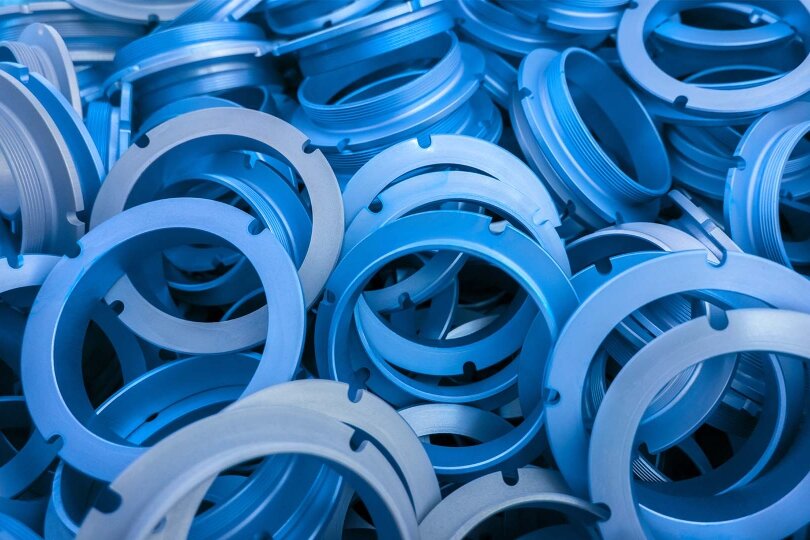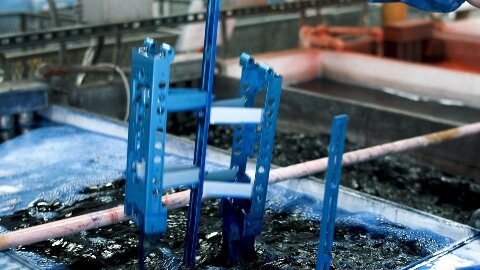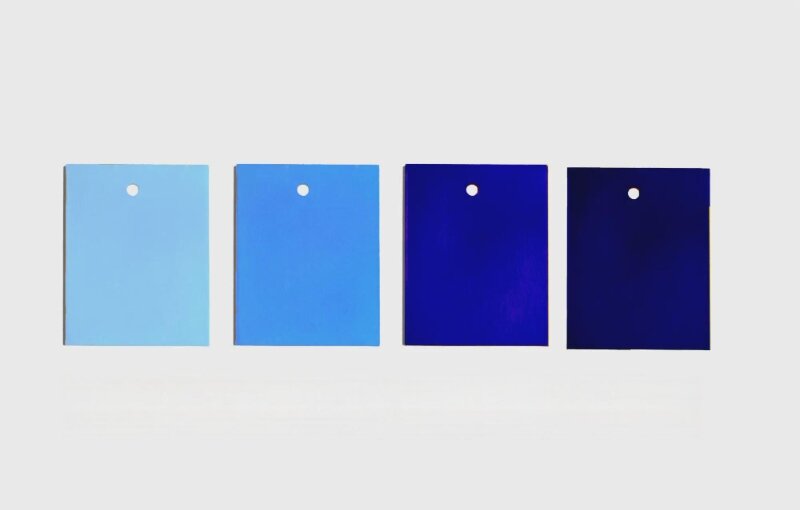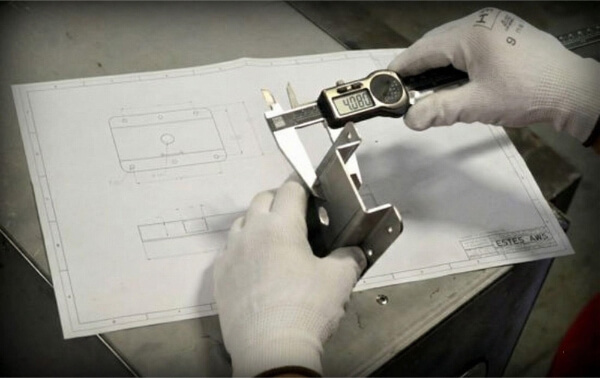Во многих отраслях промышленности требуются металлические детали, которые выделяются на фоне других, служат дольше или противостоят износу и коррозии. Возможно, вам нужны металлические детали с синей отделкой по внешним или практическим причинам, но вы не знаете, как это работает. Процесс создания этого "анодированного синего" цвета не очевиден с первого взгляда, и сделать правильный выбор - значит знать детали.
Что отличает анодированный синий цвет от других видов отделки? Давайте разберемся, как она работает, что предлагает и куда лучше всего вписывается.

Что означает "анодированный синий"?
Анодированный синий означает алюминий или другой металл, который был анодирован, а затем окрашен в синий цвет. Анодирование - это электрохимический процесс. В ходе него на поверхности металла утолщается естественный оксидный слой. Этот слой твердый, износостойкий и пористый.
После анодирования металл может впитывать цветные красители. Синий краситель добавляется в пористый слой, а затем металл запечатывается, чтобы зафиксировать цвет. В результате получается прочная цветная поверхность, которая хорошо выглядит и долго служит.
Синий - один из самых востребованных цветов для анодированных деталей. Он придает чистый, современный вид, и многие технологические бренды, производители инструментов и медицинского оборудования выбирают именно его. Его легко заметить, но он не слишком бросается в глаза.
Синие анодированные детали используются как для внешнего вида, так и для функциональности. Цвет может указывать на брендинг, сигнализировать о типах деталей или помогать в обеспечении безопасности и сортировки. Синий цвет также противостоит выцветанию под воздействием света и тепла, что делает его надежным выбором в различных отраслях промышленности.
Процесс анодирования алюминия синим цветом
Анодирование алюминия включает в себя несколько этапов, каждый из которых помогает создать прочную цветную поверхность. Вот как необработанный алюминий превращается в яркую деталь с синей отделкой.
Очистка и подготовка поверхности
Сначала алюминий необходимо очистить. Масла, грязь и окислы удаляются с помощью щелочных или кислотных очистителей. Чистая поверхность - ключевой момент. Любые остатки могут испортить покрытие.
Затем деталь можно подвергнуть травлению. Этот шаг сглаживает поверхность и удаляет мелкие царапины. Затем деталь промывают в деионизированной воде, чтобы удалить химические вещества перед началом анодирования.
Электрохимическое образование оксидов
Очищенный алюминий помещается в кислотную ванну. Затем подается электрический ток. Алюминий становится анодом, а катод (часто свинец или нержавеющая сталь) завершает цепь.
При прохождении тока выделяется кислород. Он вступает в реакцию с алюминием, в результате чего образуется оксидный слой. Этот слой пористый и гораздо более сложный, чем необработанный алюминий. Его толщина зависит от напряжения, времени и температуры.
Окрашивание с помощью красителя или электролита
После образования оксида деталь готова к окрашиванию. Существует два способа добавления синего цвета:
- Метод окрашивания: Деталь погружается в ванну с синим красителем, где краситель впитывается в пористый оксидный слой. Это самый распространенный способ получения анодированного синего цвета.
- Электролитическое окрашивание: В этом методе для создания цвета используются соли металлов и ток. Он реже используется для синего цвета и чаще для бронзового или черного.
Метод окрашивания дает яркий, устойчивый цвет и больше возможностей для регулирования оттенка.
Уплотнение оксидного слоя
Последний этап - герметизация. Деталь помещают в кипящую воду или раствор ацетата никеля. Это закрывает поры в оксидном слое и фиксирует краситель.
Герметизация повышает коррозионную стойкость и предотвращает выцветание цвета. Кроме того, поверхность становится более гладкой на ощупь. После герметизации деталь готова к использованию.

Как достигается синий цвет при анодировании?
Создание синего анодированного покрытия зависит от того, как цвет вводится в оксидный слой. Используются два основных метода, и конечный результат зависит от нескольких факторов.
Использование органических красителей
Наиболее распространенный способ получения анодированного синего цвета - использование органических красителей. После анодирования пористый оксидный слой готов к поглощению красителя. Деталь погружают в ванну с красителем, наполненную синим пигментом. Краситель заполняет поры и соединяется с поверхностью.
Различные типы красителей и время погружения меняют глубину и тон синего цвета. Одни красители дают глубокий темно-синий цвет, другие - более светлый или яркий голубой.
Использование электролитического окрашивания
При электролитическом окрашивании используется второй электрический процесс после анодирования. Соли металлов, например олова или кобальта, добавляются в поры с помощью электрического тока. Этот метод позволяет получить цвет за счет осаждения металла, а не красителей.
Электролитическое окрашивание часто используется для бронзовых, черных или финишных покрытий, поскольку добиться синих оттенков сложнее. Тем не менее, некоторые системы могут получить темный голубоватый оттенок таким способом.
Факторы, влияющие на затененность и равномерность
На конечный цвет влияют несколько факторов:
- Толщина оксида: Более толстые слои впитывают больше краски, обеспечивая более темный цвет.
- Тип и качество красителя: Различные красители дают разные оттенки и светостойкость.
- Время в красильной ванне: Длительное погружение в воду делает цвет более глубоким.
- Температура: На конечный результат влияют как температура красителя, так и температура запечатывания.
- Материал сплав: Различные марки алюминия по-разному реагируют на анодирование.
- Подготовка поверхности: Шероховатая поверхность неравномерно впитывает краситель, что приводит к появлению пятнистого цвета.
Типы анодированных синих покрытий
Детали с синим анодированием могут иметь различный внешний вид. Окончательная отделка зависит от того, как алюминий был подготовлен и обработан перед анодированием. Вот наиболее распространенные виды отделки.
Прозрачный анодированный синий
Эта отделка имеет гладкий, натуральный металлический вид с легким голубым оттенком. Алюминий обычно полированный или матовый перед анодированием, окрашиванием и герметизацией. Текстура металла видна в основном под цветом.
Этот тип популярен благодаря своему цвету и чистому металлическому оттенку. Его часто можно встретить в электронике, инструментах и потребительских товарах.
Матовый анодированный синий
Матовая отделка производится путем травления или пескоструйная обработка поверхность перед анодированием. Это удаляет блеск и создает мягкий, плоский вид. Затем деталь анодируется и окрашивается в синий цвет.
Матовые синие анодированные детали не отражают свет, что делает их полезными в случаях, когда блики являются проблемой, например, при работе с наружным оборудованием, освещением или медицинскими инструментами.
Глянцевый анодированный синий
Глянцевые покрытия получаются в результате полировки алюминия до зеркальной поверхности перед анодированием. Гладкая поверхность отражает больше света, даже после окрашивания и герметизации.
Эту отделку часто выбирают для декоративных деталей или изделий, где внешний вид имеет первостепенное значение. Она дает яркий, поразительный синий цвет, который выглядит очень дорого.

Свойства анодированных синих поверхностей
Анодированные синие поверхности не просто хорошо выглядят. Они обладают ключевыми эксплуатационными преимуществами, которые делают их полезными во многих отраслях промышленности. Ниже перечислены основные свойства, определяющие их ценность.
Устойчивость к коррозии
Анодирование создает толстый, устойчивый оксидный слой, который защищает металл под ним. Этот слой блокирует попадание влаги, воздуха и химических веществ на поверхность металла, замедляя коррозию даже в соляном тумане или во влажной среде.
При соответствующем уплотнении анодированный слой противостоит ржавчине и точечной коррозии, что делает его хорошим выбором для использования на открытом воздухе, в морских и промышленных условиях.
Твердость и долговечность поверхности
Анодированный слой намного тверже необработанного алюминия. Он противостоит царапинам, износу и истиранию при ежедневном использовании, что делает анодированную синюю отделку полезной для деталей, которые обрабатываются, перемещаются или подвергаются трению.
Поверхность также устойчива к отслаиванию или шелушению, поскольку оксидный слой растет изнутри металла, а не только сверху.
Устойчивость к ультрафиолетовому излучению и выцветанию
Качественные синие красители, предназначенные для анодирования, хорошо переносят солнечный свет. При правильной герметизации цвет хорошо держится под воздействием ультрафиолета. Это очень важно для деталей, находящихся на открытом воздухе, или изделий, которые долгое время находятся под прямым светом.
Более дешевые красители могут выцветать быстрее. Поэтому важно использовать устойчивые к ультрафиолетовому излучению красители и хорошо запечатывать поверхность.
Визуальная привлекательность и отражающая способность
Анодированный синий цвет имеет чистый, современный вид, который нравится многим отраслям промышленности. Он может варьироваться от мягкого и матового до яркого и глянцевого. Отделка подчеркивает текстуру металла, делая каждую деталь уникальной.
Он также отражает свет, придавая цвету глубину и насыщенность. Это делает его полезным в брендинге, дизайне продуктов и бытовой электроники.
Преимущества анодированных синих покрытий
Анодированные синие поверхности популярны не зря. Они сочетают в себе внешний вид, функциональность и экологичность. Ниже приведены некоторые очевидные преимущества, которые делают их надежным выбором.
Эстетическая гибкость
Анодированный синий цвет - это смелый, но профессиональный вид. Процесс позволяет создать множество стилей, и вы можете контролировать оттенок, отделку и яркость. Хотите ли вы мягкое матовое или глянцевое покрытие - процесс позволяет выбрать множество вариантов.
Такая гибкость позволяет легко подбирать фирменные цвета, создавать визуальный контраст или обозначать типы деталей в сборках. Она также хорошо подходит как для промышленных, так и для потребительских товаров.
Долгосрочные результаты
Анодированный слой не расслаивается и не отслаивается. Он устойчив к износу, царапинам и атмосферным воздействиям. При правильной герметизации цвет остается ярким в течение многих лет.
В отличие от краски или гальванического покрытия, анодирование сцепляется с металлом. Это означает меньшее количество повторных работ и меньший риск повреждения при обработке или транспортировке.
Экологически чистый
Анодирование - один из самых чистых способов обработки поверхности. В нем не используются тяжелые металлы или токсичные покрытия. Основные химикаты можно использовать повторно, а отходы легче утилизировать.
Процесс также укрепляет основной металл, снижая необходимость замены или ремонта. Это снижает расход материалов и способствует увеличению срока службы изделий.
Сравнение с другими видами отделки
Выбор правильной отделки зависит от характеристик вашего изделия. Вот как синий цвет сопоставляется с другими стандартными вариантами отделки алюминиевых деталей.
| Категория | Анодированный синий | Окрашенный синий | Порошковое покрытие синего цвета | Натуральный анодированный |
|---|---|---|---|---|
| Тип | Электрохимическое покрытие | Жидкое покрытие | Электростатическое порошковое покрытие | Электрохимическое покрытие |
| Появление | Голубой металлик, от матового до глянцевого | Различные синие оттенки, глянцевые или матовые | Гладкая, однородная голубая поверхность | Серебристо-серый металлик |
| Долговечность | Высокий | От низкого до среднего | От среднего до высокого | Высокий |
| Устойчивость к коррозии | Высокий | Средний | Высокий | Высокий |
| Стойкость цвета | Отличный | От плохого до хорошего | Хороший | Отличный |
| Обслуживание | Низкий | Высокий | Средний | Низкий |
| Текстура поверхности | Видимая текстура алюминия | Скрыт под слоем краски | Гладкая и толстая поверхность | Видимая текстура алюминия |
Общие области применения анодированного синего цвета
Анодированный синий цвет используется во многих отраслях промышленности. Оно обеспечивает долговечность, чистый внешний вид и сильную коррозионную стойкость. Вот некоторые из наиболее распространенных вариантов применения.
Бытовая электроника
В ноутбуках, смартфонах и аудиоаппаратуре часто используются детали из анодированного алюминия синего цвета. Такое покрытие придает поверхности элегантный современный вид, защищая ее от царапин и отпечатков пальцев.
Бренды также используют этот цвет, чтобы выделиться или соответствовать темам дизайна. Анодирование сохраняет стабильность цвета, не влияя на работу устройства.
Архитектурные элементы
Двери, оконные рамы, панели и перила иногда окрашивают в синий анодированный цвет. Этот цвет придает зданиям визуальный акцент и одновременно защищает металл от солнца, дождя и загрязнения.
Поверхность хорошо держится на открытом воздухе и не требует особого ухода, что делает ее отличным выбором для длительного использования.
Автомобильная промышленность
Для таких деталей, как ручки переключения передач, накладки, педали и крышки двигателя, используется анодированное покрытие синего цвета, обеспечивающее как внешний вид, так и защиту. Такое покрытие выделяется, противостоит нагреву и хорошо держит форму.
Он также используется в гоночных и мотоциклетных компонентах для снижения веса и придания стиля.
Аэрокосмическая промышленность
В интерьерах самолетов и конструктивных элементах может использоваться анодированный синий цвет для снижения веса, предотвращения коррозии и улучшения отслеживания деталей. Цвет помогает идентифицировать различные типы деталей и повышает долговечность без увеличения объема.
Аэрокосмическая промышленность ценит анодирование за его надежную работу в экстремальных условиях.
Заключение
Анодированный синий цвет - это прочное и привлекательное покрытие, созданное с помощью электрохимического процесса. Оно повышает коррозионную стойкость, твердость поверхности и визуальную привлекательность. Синий цвет добавляется с помощью красителей или электролитических методов и запечатывается для сохранения характеристик. Он используется в электронике, медицинских инструментах, автомобильных деталях и архитектуре.
Ищете синие анодированные детали с надежными характеристиками и чистым покрытием? Свяжитесь с нами сегодня для получения бесплатного предложения и экспертной поддержки.
Привет, я Кевин Ли

Последние 10 лет я занимался различными формами изготовления листового металла и делился здесь интересными идеями из своего опыта работы в различных мастерских.
Связаться

Кевин Ли
У меня более десяти лет профессионального опыта в производстве листового металла, специализирующегося на лазерной резке, гибке, сварке и методах обработки поверхности. Как технический директор Shengen, я стремлюсь решать сложные производственные задачи и внедрять инновации и качество в каждом проекте.




